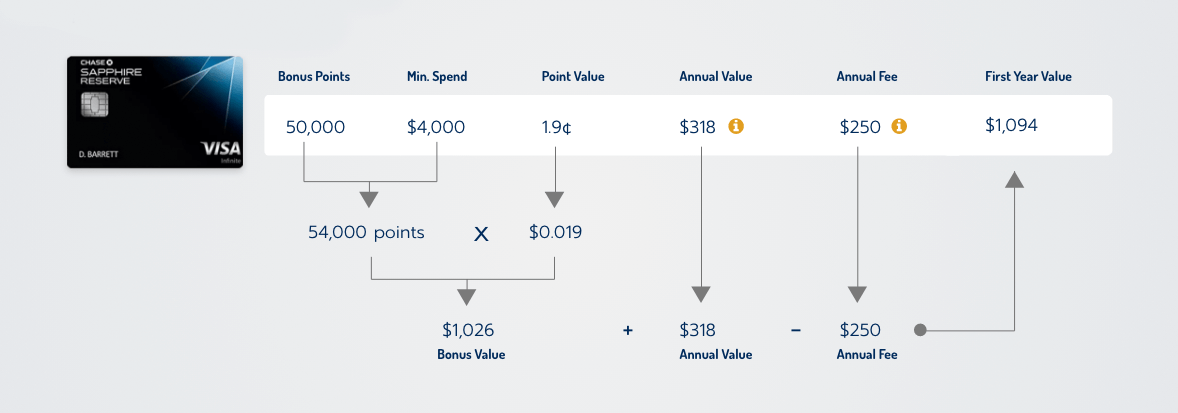
General
Points Navigator Ranking Methodology
May 26th, 2020
** Writer’s Note: The phrases you find in parenthesis (“ “) are quotes directly from our tooltips associated with each category.
One of the things that makes the Point Navigator unique is that our card rankings and recommendations are based on objective numbers and formulas -- not subjective opinions (that can be influenced by bank advertising money.) So naturally people want to understand the details behind them.
If you’re a numbers person, we think you’ll really appreciate the attention to detail. If you aren’t, you’ll just be thankful someone else is doing all this number crunching for you.
Comprehensive Value Inclusion
We set out to make the Points Navigator both user-friendly and comprehensive. In the credit card and points game, that’s an oxymoron. We felt being comprehensive was vital, however, as it’s missing from most sites, and immediately calls into question any recommendations.
To achieve this “value inclusion” synergy, we arrived at a simple test question: “Is there a use case for which we would recommend a card for inclusion?” With that in mind, we purposefully chose to omit cards, point systems and banks for which no one could make a practical use case.
The results:
- Top 90 Cards, including unique use cases for this hobby like best cash back, huge Amazon or Costco spends.
- Top 32 Point Systems, with an additional 49 shown only for airline alliance purposes
- Top 9 Banks, and the approval rules that accompany them
- Top 21 Spend Categories
- Top 21 Card Benefits
If you think we missed a viable use case, feel free to shoot us an email with the scenario for potential inclusion. Just be prepared for a “devil’s advocate” exchange.
Point Value

This one is straightforward. We define “point value” as: “The average value of a point when following our usage suggestions.” In determining this, we tested 5 recommended uses of that system’s points and averaged the value.
We'll break down Chase as an example:
- Booking an international business class flight by transferring to United: 2.7 cents
- Booking an all-inclusive resort by transferring to Hyatt: 1.8 cents
- Booking a domestic flight by transferring to Southwest 1.5 cents
- Booking a rental car through Chase portal 1.25 cents (with Sapphire or Ink Card)
- Booking cruise through the Chase portal: 1.25 cents (with Sapphire or Ink Card)
Our valuation is 1.7 cents for Chase Points.
Further, this point valuation is adjusted on certain cards like the Sapphire Reserve (1.5 cents in Chase Portal) because the values on the use cases change. That allows us to objectively, numerically rank the two Sapphire Cards as an example.
Bonus Value

The schematic for Bonus Value is simple: “A calculation of bonus points plus the points associated with the minimum spend, multiplied by Point Value" We’ll just show our math for this one. We’ll use the Sapphire Reserve, 50,000 point bonus on a $4,000 spend. Once you have spent the $4,000, you’ll have 54,000 points (we know there are variables, but they tend to offset in other calculations) We multiply that by the 1.9 cent value for Chase points if you have the Sapphire Reserve. Bonus value = $1,026.
Annual Value
What’s the actual annual value of a card? We attack that question like this: “A calculation of likely to be used benefits and spend category multiplier(s).” How do we objectively decide what is likely to be used and the valuation on these?
Let’s start with Benefits:
- We rank all 90 cards for each benefit based on objective factors, ranking only the top 3-5 as the plus (or preferred) card for that benefit.
- Only if a card is in this top 3-5% of cards is the value for that benefit included in likely to be used.
- Valuation of a benefit is the most subjective part of the equation. We did our best to objectively value each benefit factoring in how often it would likely be used annually for the average person (lower than [1] for some benefits such as TSA precheck, which is once every 5 years [.2]).
Spend Categories:
- We rank all 90 cards by actual cents back per dollar spent, not simply as a multiplier
- Only the top 4% of cards are included for each category
- We then multiply the cents per dollar by 50% an average family spend in that category.
- Why 50%? We assume at least half of your annual spend will go towards card bonuses
- Average family spend? Every user can customize their spend and the annual value calculations will update on their personalized recommendations page.
Annual Fee
What’s the real annual fee for each card? We came up with a simple formula: “The net annual fee for year one.” We display year one for “card picking” purposes with a tooltip explaining any year two variations. The ongoing annual fee is displayed on My Cards page, as this is more likely to be for “card cancelling” purposes.
Why “NET annual fee”? For two cards (Sapphire Reserve & Citi Prestige), we subtracted the travel credit from the annual fee. This is not to be misleading. As with everything on the site, we match it to “likely use case.” We’ve never met anyone who hasn’t received this credit. So for the calculations and recommendations of the site to be more in-line with actual use, we represented it off the annual fee with a clear tooltip explanation.
For something like the $200 credit on one select airline from Amex Platinum, we included the prorated amount in annual value. To be fair, this is handled differently because many people aren’t able to fully take advantage of that benefit.
1st Year Value

Here’s how we figured our 1st Year Value:“Calculation of Bonus Value + Points from Minimum Spend + Annual Value - Annual Fee.” We’ll just show our math for this one. We’ll use the Sapphire Reserve, 50,000 point bonus on a $4,000 spend. Once you have spent the $4,000, you’ll have 54,000 points. We multiply that by the 1.9 cent value for Chase points (value if you have the Sapphire Reserve). So bonus value + points from min. spend = $1,026. Plus $318 annual value, minus $250 Net Annual Fee = a 1st Year Value of $1094
This number is the basis on which the cards are ranked. Is it precisely right for every person? No. But we do feel it is the most objective way cards are ranked anywhere on the web.
It is worth noting here, that in this hobby, the card “selection” process is generally a different consideration than the process of deciding to “keep” a card going forward. This can be evaluated on our card cancellation tool, for which you’ll receive a notification and link 45 days prior to each card’s annual fee.
Personal Value
We even endeavored to figure out your personal value for each card: “1st year value adjusted for your top priorities.” This can be found for each card on our personalized recommendations page. It’s first worth mentioning again here that if you have adjusted your annual spend categories, your “Annual Value” and “1st year value” will adjust accordingly.
Our system allows you to pick up to three priorities out of 5 categories:
- International Airfare
- Domestic US Airfare
- Hotel Stays
- Flexibility
- Ease of Use
Based on how the rating of each card matches (or doesn’t match) your selections, the Annual Value is algorithmically adjusted to your personal value. As your priorities switch, this can be adjusted permanently in My Account > My Profiles > Profile Settings, or temporarily on the Personalized Recommendation filters.
Value Retained on Transfer
Here’s a simple but important calculation when you transfer points: “Value of points system being transferred from ÷ value of point destination.” Circumstances vary. For example, if you are 1,000 points short on two international flights, the value of those points in the destination system is priceless. For understanding potential options for finding good value in your point transfers, though, these numbers are a uniquely useful guide.
 Working With Others For Way More Points!
Working With Others For Way More Points! How To Maximize Cards Under 5/24 Rule
How To Maximize Cards Under 5/24 Rule Will It Be A Pain To Keep Track Of Everything?
Will It Be A Pain To Keep Track Of Everything?